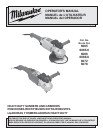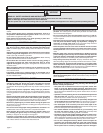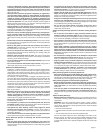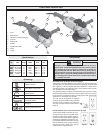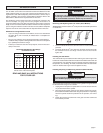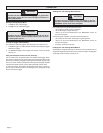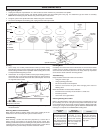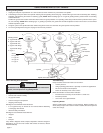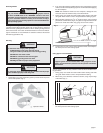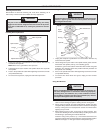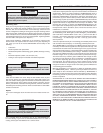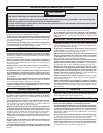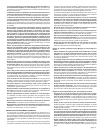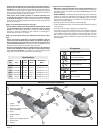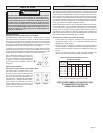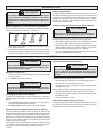page 3
install an undamaged accessory. After inspecting and installing an
accessory, position yourself and bystanders away from the plane of
the rotating accessory and run the power tool at maximum no-load
speed for one minute. Damaged accessories will normally break apart
during this test time.
• Wear personal protective equipment. Depending on application,
use face shield, safety goggles or safety glasses. As appropriate,
wear dust mask, hearing protectors, gloves and work shop apron
capable of stopping small abrasive or workpiece fragments. The
eye protection must be capable of stopping fl ying debris generated
by various operations. The dust mask or respirator must be capable of
fi ltrating particles generated by your operation. Prolonged exposure to
high intensity noise may cause hearing loss.
• Keep bystanders a safe distance away from work area. Anyone
entering the work area must wear personal protective equipment.
Fragments of workpiece or of a broken accessory may fl y away and cause
injury beyond immediate area of operation.
• Hold power tool by insulated gripping surfaces only, when perform-
ing an operation where the cutting accessory may contact hidden
wiring or its own cord. Cutting accessory contacting a live wire may
make exposed metal parts of the power tool live and shock the opera-
tor.
• Position the cord clear of the spinning accessory. If you lose control,
the cord may be cut or snagged and your hand or arm may be pulled into
the spinning accessory.
• Never lay the power tool down until the accessory has come to a
complete stop. The spinning accessory may grab the surface and pull
the power tool out of your control.
• Do not run the power tool while carrying it at your side. Accidental
contact with the spinning accessory could snag your clothing, pulling the
accessory into your body.
• Regularly clean the power tool’s air vents. The motor’s fan will draw
the dust inside the housing and excessive accumulation of powdered
metal may cause electrical hazards.
• Do not operate the power tool near fl ammable materials. Sparks could
ignite these materials.
• Do not use accessories that require liquid coolants. Using water or
other liquid coolants may result in electrocution or shock.
Kickback and Related Warnings
Kickback is a sudden reaction to a pinched or snagged rotating wheel,
backing pad, brush or any other accessory. Pinching or snagging causes
rapid stalling of the rotating accessory which in turn causes the uncon-
trolled power tool to be forced in the direction opposite of the accessory’s
rotation at the point of the binding.
For example, if an abrasive wheel is snagged or pinched by the work-
piece, the edge of the wheel that is entering into the pinch point can dig
into the surface of the material causing the wheel to climb out or kick out.
The wheel may either jump toward or away from the operator, depending
on direction of the wheel’s movement at the point of pinching. Abrasive
wheels may also break under these conditions.
Kickback is the result of power tool misuse and/or incorrect operating
procedures or conditions and can be avoided by taking proper precau-
tions as given below.
• Maintain a fi rm grip on the power tool and position your body and
arm to allow you to resist kickback forces. Always use auxiliary
handle, if provided, for maximum control over kickback or torque
reaction during start-up. The operator can control torque reactions or
kickback forces, if proper precautions are taken.
• Never place your hand near the rotating accessory. Accessory may
kick back over your hand.
• Do not position your body in the area where power tool will move
if kickback occurs. Kickback will propel the tool in direction opposite to
the wheel’s movement at the point of snagging.
• Use special care when working corners, sharp edges etc. Avoid
bouncing and snagging the accessory. Corners, sharp edges or
bouncing have a tendency to snag the rotating accessory and cause loss
of control or kickback.
• Do not attach a saw chain woodcarving blade or toothed saw blade.
Such blades create frequent kickback and loss of control.
Safety Warnings Specific for Grinding and Abrasive Cutting-Off
Operations:
• Use only wheel types that are recommended for your power tool
and the specifi c guard designed for the selected wheel. Wheels for
which the power tool was not designed can not be adequately guarded
and are unsafe.
• The guard must be securely attached to the power tool and posi-
tioned for maximum safety, so the least amount of wheel is exposed
towards the operator. The guard helps to protect operator from broken
wheel fragments and accidental contact with wheel.
• Wheels must be used only for recommended applications. For ex-
ample: do not grind with the side of cut-off wheel.
Abrasive cut-off
wheels are intended for peripheral grinding, side forces applied to these
wheels may cause them to shatter.
• Always use undamaged wheel fl anges that are of correct size and
shape for your selected wheel. Proper wheel fl anges support the wheel
thus reducing the possibility of wheel breakage. Flanges for cut-off wheels
may be different from grinding wheel fl anges.
• Do not use worn down wheels from larger power tools. Wheel
intended for larger power tool is not suitable for the higher speed of a
smaller tool and may burst.
Additional Safety Warnings Specifi c for Abrasive Cutting-Off Opera-
tions:
• Do not jam the cut-off wheel or apply excessive pressure. Do not
attempt to make an excessive depth of cut. Overstressing the wheel
increases the loading and susceptibility to twisting or binding of the wheel
in the cut and the possibility of kickback or wheel breakage.
• Do not position your body in line with and behind the rotating wheel.
When the wheel, at the point of operation, is moving away from your body,
the possible kickback may propel the spinning wheel and the power tool
directly at you.
• When wheel is binding or when interrupting a cut for any reason,
switch off the power tool and hold the power tool motionless until the
wheel comes to a complete stop. Never attempt to remove the cut-off
wheel from the cut while the wheel is in motion otherwise kickback
may occur. Investigate and take corrective action to eliminate the cause
of wheel binding.
• Do not restart the cutting operation in the workpiece. Let the wheel
reach full speed and carefully reenter the cut. The wheel may bind,
walk up or kickback if the power tool is restarted in the workpiece.
• Support panels or any oversized workpiece to minimize the risk of
wheel pinching and kickback. Large workpieces tend to sag under their
own weight. Supports must be placed under the workpiece near the line
of cut and near the edge of the workpiece on both sides of the wheel.
• Use extra caution when making a “pocketcut” into existing walls
or other blind areas. The protruding wheel may cut gas or water pipes,
electrical wiring or objects that can cause kickback.
Safety Warnings Specifi c for Sanding Operations:
• Do not use excessively oversized sanding disc paper. Follow manu-
facturers recommendations, when selecting sanding paper. Larger
sanding paper extending beyond the sanding pad presents a laceration
hazard and may cause snagging, tearing of the disc or kickback.
Safety Warnings Specifi c for Wire Brushing Operations:
• Be aware that wire bristles are thrown by the brush even during or-
dinary operation. Do not over stress the wires by applying excessive
load to the brush. The wire bristles can easily penetrate light clothing
and/or skin.
• If the use of a guard is recommended for wire brushing, do not al-
low any interference of the wire wheel or brush with the guard. Wire
wheel or brush may expand in diameter due to workload and centrifugal
forces.
Additional Safety Warnings
• Maintain labels and nameplates. These carry important information. If
unreadable or missing, contact a MILWAUKEE service facility for a free
replacement.
• WARNING: Some dust created by power sanding, sawing, grinding,
drilling, and other construction activities contains chemicals known to
cause cancer, birth defects or other reproductive harm. Some examples
of these chemicals are:
• lead from lead-based paint
• crystalline silica from bricks and cement and other masonry products,
and
• arsenic and chromium from chemically-treated lumber.
Your risk from these exposures varies, depending on how often you do
this type of work. To reduce your exposure to these chemicals: work in
a well ventilated area, and work with approved safety equipment, such
as those dust masks that are specially designed to fi lter out microscopic
particles.



